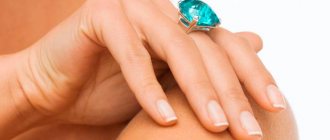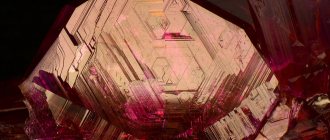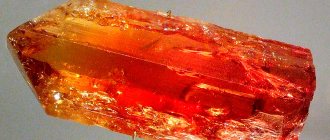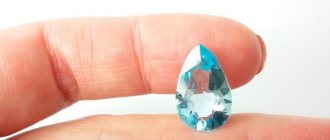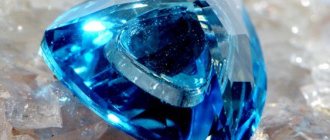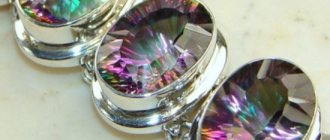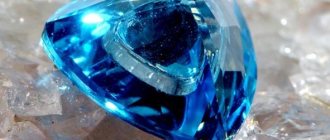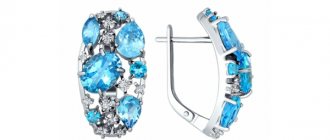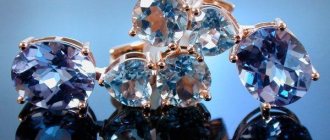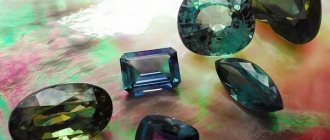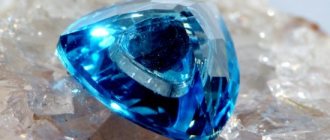BIG DIFFERENCE: PROCESSED OR ARTIFICIAL
Processed stones stand apart from real and fake gems.
It is difficult to call processed minerals “artificial”: they are almost identical to real ones.
| PROCESSED |
|
| ARTIFICIAL |
|
Varieties of shades
3 varieties of processed blue topaz became dominant:
- Swiss Blue is a bright blue topaz with a light to moderate tone and saturation. The vibrant color of Swiss blue is reminiscent of the rich hue of the Caribbean, which is close to the color of Brazilian Paraiba tourmaline. It is darker than heavenly and has a slightly "electric" tone.
- London Blue is a medium to dark blue topaz. London Blue is so deep that the slightly greenish tint is barely visible when viewed from an angle. It is exactly like tanzanite. This color is also called “inky” and “stylish”. This stone is considered the most valuable among other members of the topaz family.
- Sky Blue is the lightest, most subtle stone giving a bluish glow.
It is difficult to determine the boundary where a shade of blue ends and another begins. A simple rule of thumb applies around the world: medium blue is Swiss and dark blue is London.
Three shades of one stone.
VARIETY OF TOPAZES AND FINISHES
Blue
The blue shade is the most recognizable: most people associate topaz with it. Shades range from pale to deep blue, or “London”.
Synthetic topaz is usually also blue. Rare natural cornflower blue minerals are mined in Brazil.
We recommend: Determining a REAL DIAMOND
Champagne
Truly regal and luxurious - a champagne-colored mineral. Such stones are often counterfeited - after all, the shade is rarely found in nature and costs hundreds of dollars.
Imperial
Imperial are called yellow, orange or red topazes. Despite their beauty, these stones are not in demand.
The rarest imperials are pink minerals. By the way, a natural stone is unmistakably distinguished by its pink hue: like colorless topaz, such topaz cannot be faked.
Rauchtopaz
“Smoky” (translated from German) topaz is nothing more than a type of quartz. Sellers may “forget” to explain this difference. The gem is a beautiful and deep brown shade, but should be sold as quartz.
Types of fakes
When processing these stones, jewelers often equip topaz with auxiliary rhinestones or special colored glasses. This does not affect the properties of the stone and is not a sign of a fake. This stone is very popular and is not very expensive, so jewelry craftsmen make products with topaz more pleasing to the eye and add gloss and an unusual iridescent hue. The first thing you need to pay attention to is the name. Rauchtopaz has nothing in common with topaz. Rauchtopaz is the scientific name for smoky quartz. Very often, unscrupulous sellers pass off rauchtopaz gems as semi-precious crystals. When answering the question of how to distinguish topaz from quartz, you should resort to knowledge about their physical properties: hardness and density.
On topic: London Topaz. Properties
As previously noted, topazes come in different colors; you can find dark red, amber, blue or soft pink shades. Most often, natural crystal has a light shade. Such minerals are found very often, their extraction is not difficult, and therefore their price is low. It follows from this that it is not profitable to counterfeit such stones. Rare pink and red minerals are counterfeited much more often, because their price is higher than average. In order to be absolutely sure that you are paying a tidy sum for natural topaz, it is better to hand it over to jewelry professionals who know exactly how to distinguish real topaz from a fake.
Compatibility with zodiac signs
Topaz is associated with Jupiter, the largest planet in the solar system. It has always been considered the abode of greatness. Jupiter is the ruler of Sagittarius and Pisces.
The stone is also favorable for Aries, Cancer and Leo, Scorpio. He will protect and inspire Virgos. For Taurus and Gemini, such an amulet will not bring a favorable result, but it will not cause harm either.
According to astrological rules, Libra, Capricorn and Aquarius cannot wear this mineral all the time. You can wear jewelry to an event if it is irresponsible.
People born under the sign of Sagittarius can wear the mineral as a talisman for good luck. This is their stone.
Stone in gold and silver for Sagittarius and Pisces.
How to distinguish a real stone from a fake
The only sure way to determine originality is to find a certified gemologist to perform tests. Most jewelry stores have such a specialist.
So much work goes into Swiss topaz that without proper gemstone equipment it is difficult to determine its authenticity.
Several ways to visually distinguish Swiss Blue from a fake:
- original stones are inlaid with expensive metal;
- when touched, a polished, slippery surface is felt;
- the mineral cannot be easily scratched, and cheap quartz will remain damaged;
- in the rays of the sun, shades of gray are observed on the edges of the original product;
- real stone is heavy;
- the actual crystal remains cool even with prolonged contact with the body.
Similar products made from processed citrine or amethyst - varieties of quartz - act as counterfeits.
How to identify synthetic stone
Artificial crystals are obtained in laboratory conditions; this is a labor-intensive and expensive process. Such minerals cost less, and often look better - more transparent, with a rich color. Topazes with impurities are not considered fakes - sometimes they are added specifically during processing to give the stone the desired color.
The production of hydrothermal topaz is not economically profitable, so artificial sapphire or ruby is often used as an imitation. Analogues are similar to a real gem in appearance and repeat most of the physical properties. But synthetic stone is usually less strong and durable. Its synthesis is similar to growing flowers in a greenhouse. Scientists create the conditions necessary for a mineral to develop, monitor its growth, and purposefully influence its external qualities - color, transparency, shine. The crystals grown under such conditions are larger than in nature, their growth rate is several times faster, and the colors are more saturated: natural bright blue topaz is difficult to find in nature.
Growing stones in artificial conditions is regulated by legal acts, according to which the jewelry tag must indicate that the mineral is synthetic. If there is no information about the origin of the insert, it will not be easy to recognize synthetic topaz at home.
Its main difference from natural is the depth of shade and the complete absence of defects.
It is necessary to distinguish synthetic topaz from cubic zirconia, which has no analogue in nature and is therefore cheaper. This artificial crystal has a strong, diamond-like luster, which is not characteristic of topaz. In addition, cubic zirconia does not have the effect of pleochroism - it does not change color when the viewing angle or lighting changes.
Blue topaz price
The cost is estimated depending on the type and saturation of the color palette. The lightest models are mined most often, so their price is low. You can buy a copy for $100 per carat. The medium-rich option costs a little more - the price starts at $200.
The most expensive are London blue topazes. They have an amazing glow and rich color. An average quality stone can be purchased for $500.
Blue magic stones are suitable for the Scorpio sign. Topaz will attract good luck and give peace of mind. Jewelry with this stone is not recommended for Taurus, Pisces and Libra.
Properties
Fluorinated aluminum silicate.
Physico-chemical
- Refers to highly hard minerals.
- Crystals exhibit a piezoelectric effect.
- Insoluble in acids.
- Pleochroism: yellow stones have distinct honey, lemon, straw shades; blue has weak pink, blue; Red topaz has a strong color - red-pink, yellow, dark red.
- Sometimes crystals have a “cat’s eye” effect, opalescence.
- When irradiated or heated, the crystals change color. Yellows and browns turn to pink; colorless ones become brown.
- Irradiate the crystal, then heat it - it will turn blue!
- Coloring impurities include iron, titanium, vanadium and chromium.
M. Loiri, author of the book “Wonderful Stones. 250 minerals: history, properties and hidden features,” writes: “Topaz... one of the best stones. Legends attribute many wonderful properties to it, but in fact, topaz gives even more!
Expert opinion
Semenishcheva Polina
Specialist in mineralogy. Graduated from St. Petersburg Mining University.
Note : pleochroism is observed only in painted specimens.
Lithotherapist's book
If you wear topaz jewelry for a long time, the stone will strengthen your immunity and improve your metabolism.
Lithotherapists advise:
- Wear topaz set in silver for asthma. This will ease attacks of the disease.
- “Siberian Diamond” under your pillow will relieve insomnia.
- Blue crystals get rid of the evil eye.
- Golden and yellow topazes are suitable for people with liver and gall bladder problems. If there are disorders in the endocrine system, lithotherapists advise wearing such crystals.
- Polychrome crystals will help in the treatment of pneumonia and chronic skin inflammation.
Magic powers
The ancients believed that if you wear a topaz ring, the stone will attract wealth to you. And not only - the favor of the “powers of this world” will be guaranteed to you.
- The stone develops intuition and helps find a way out of difficult situations.
- Pink topaz harmonizes the aura, relieves fears and apprehensions.
- An irreplaceable property of the stone is that it gives a feeling of fullness of life.
- Topaz will comfort you in difficult times and share your joy.
- The energy of the gem works softly and unobtrusively. The crystal will direct energy to where it is most needed.
- The most powerful energy is found in yellow and golden crystals.
- In family life, “heavyweights” are not helpers, rather the opposite.
- Travelers cannot expect help from topaz amulets.
Expert opinion
Semenishcheva Polina
Specialist in mineralogy. Graduated from St. Petersburg Mining University.
Interesting: esotericists say that those who like to lie should not wear the stone. The gem does not like liars; in their hands it becomes cloudy and discolored.
Natural topaz: characteristics and places of extraction
The name of the stone comes from the ancient word “tapas”, which means fire in Sanskrit. Natural topaz has a rich color palette.
There are stones of blue, yellow, red, milky gray, pink, light green, amber brown and orange. Moreover, 80% of topazes mined in the world are yellow-brown in color, 15% are transparent, and the remaining 5% contains the rest of the color variety.
The crystal size can be very large. The largest topaz was found in 1966 in one of the Ukrainian deposits, its mass is 117 kg and its height is 82 cm. This mineral is often compared to diamond because it has a similar bright glass luster and almost the same density (3.53 g/cm3). Because of its heaviness, in ancient times in the Urals the stone was called a heavyweight.
The main deposits are located in Brazil, on the island of Sri Lanka, in Nigeria and a number of other African countries, Switzerland, Germany, on the Australian continent, Canada, Ukraine and Russia. In our country, in the Urals and Eastern Siberia, stones of smoky and pink color are mined.
Minerals of milky gray color are mined only in Canada, and blue ones, mainly in Brazil. A question immediately arises about the popular trademark “Swiss Blue” - Swiss blue topaz. Once upon a time, Switzerland actually had the largest deposit of blue topaz, but it dried up five centuries ago.
At the moment, the country is extracting the mineral from other small deposits, but the volumes there are small. And most stones sold under this name have undergone additional processing to artificially acquire a sky blue hue. Moreover, such a shade can be given even to the same above-mentioned milk topaz mined in Canada.
Before acquiring a noble blue hue, milky gray stones go through the following path:
- Extraction of mineral from rock.
- Cleaning and sorting by shade.
- Improvement through technical processing. This includes increasing purity, removing the gray tint from milky gray minerals, and discoloration.
Cutting, in most cases by machine.- Irradiation. At this stage, stones that previously had a milky gray tint become blue. Moreover, the richest stones are immediately sent for sale, while the pale ones are subject to further processing.
- A thin film is deposited onto pale blue stones using a magnetron, resulting in a popular variety of topaz with an iridescent glow, also called “mystic topaz.”
Physicochemical characteristics
The crystals are found in felsic igneous rocks such as rhyolite and in metamorphic rocks. In addition, topaz elements are found in pegmatite dikes and are often by-products of mining other precious minerals such as beryl.
Swiss topaz, composed of aluminum, silicon and oxygen, has a hardness rating of 8 on the Mohs scale. Its strength remains unchanged even after color enhancement procedures.
Physical and chemical properties:
- Rhombic system, rhombic-bipyramidal type of symmetry.
- The cleavage is perfect according to (001), unclear according to (101) and (011).
- The fracture ranges from stepwise to conchoidal.
- The shape of the crystals is prismatic, elongated along the C axis.
- The mineral does not melt and becomes cloudy when heated strongly.
- Swiss topaz decomposes with phosphorus salt to form a SiO2 skeleton.
- Behavior in acids: insoluble in HCl, releases a little HF in H2SO4 upon prolonged heating, dissolves in HNO3 after fusion with calcium carbonate.
- Formula - Al2 [SiO4] (F, OH)2.
- Content (in%): А2О3 (48.2-62); SiO2 (28.2-39); F 13 to 20.4; H2O up to 2.45. Impurities of iron, chromium, magnesium, titanium, and vanadium are noted.
